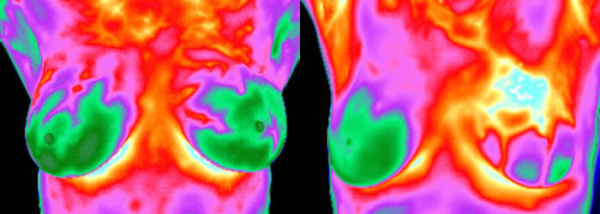Spotlight on Breast Health and Early Screening for Breast Cancer
You may know that October is Breast Cancer Awareness month, but any time of year is a good time to focus on screening and prevention. Infrared Breast Thermography offers an early detection method for tissue abnormalities and the development of breast cancer.
Breast Cancer is a leading concern for all women and is becoming more common among men. As a woman in the United States, you have a 1 in 8 chance of developing breast cancer at some point in your lifetime. Fortunately, nearly all breast cancers can be treated successfully if they are detected early on. The five-year survival rate for women whose breast cancer was found and treated in its early stages is nearly 100%. Detecting breast cancer early gives you a lifesaving head start on the road to treatment and optimal health. Infrared Breast Thermography is an excellent early detection method that can be an adjunct to other diagnostic tools.
 What exactly is Infrared Breast Thermography?
What exactly is Infrared Breast Thermography?
Infrared Thermography uses an FDA approved medical grade infrared camera to detect subtle variations of heat radiating from the surface of the body. Its use in cancer prevention and early detection is based on the principle that as a cancerous tumor develops, there is increased circulation and metabolic activity in the area, which correlates to a rise in radiant heat detected by the infrared camera.
These metabolic changes can be identified well before a noticeable mass develops, even up to 8 years earlier. For example, in the case of inflammatory Breast Cancer, there are no lumps to be detected by self-exam or mammography.
How is Infrared Thermography different from traditional Mammography?
Unlike Mammography, Infrared Thermography is an entirely non-contact and pain-free procedure and does not involve radiation exposure. Mammography uses an X-ray to capture an image that is a shadow of dense structures in the breast. It has an 80% sensitivity, which means it correctly identifies malignant tumors 80% of the time in women over age 50. It has a lower sensitivity in women under age 50.
Difficulties in reading mammograms can occur in women on hormone replacement, who are nursing, or have fibrocystic, large, dense, or enhanced breasts. These types of breast differences do not cause complications in reading digital infrared scans. Thermography is designed to be an adjunctive screening method and is best used in combination with other screening tools.
Thermography has a 90% sensitivity in women of all ages. Since it detects physiological changes in tissue, a positive infrared image is the highest known risk factor for the existence of future development of breast cancer. It is important to note that neither Mammography nor Thermography diagnoses breast cancer. Only a biopsy can determine if a questionable area is malignant.
Just as unique as a fingerprint, each patient has a particular infrared map of their breasts. Any variation of this infrared map on serial imaging (images taken over months to years) may indicate an early sign of abnormality. Stay proactive and in charge of your health by making Infrared Thermography a part of your annual routine.
BioCenter Breast Health Lab Profile
The Riordan Clinic Breast Health profile is a proactive approach to breast cancer prevention. This profile looks at several factors contributing to immune health and DNA stability.
Antioxidants protect healthy cells from damage caused by free radicals. Research has shown antioxidants can help prevent the free radical damage that can lead to cancer. Antioxidants included in Riordan Clinic’s breast health profile include Vitamin A, Vitamin C, Vitamin E, Lycopene, and Coenzyme Q 10.
Vitamin B6 and folic acid participate in the pathways that facilitate methylation, which is important for DNA synthesis and repair.
Selenium is a natural trace element that plays several roles related to breast health, such as immune support, free radical protection, and healthy DNA synthesis.
Vitamin D is an essential player in the proper functioning of the immune system.





